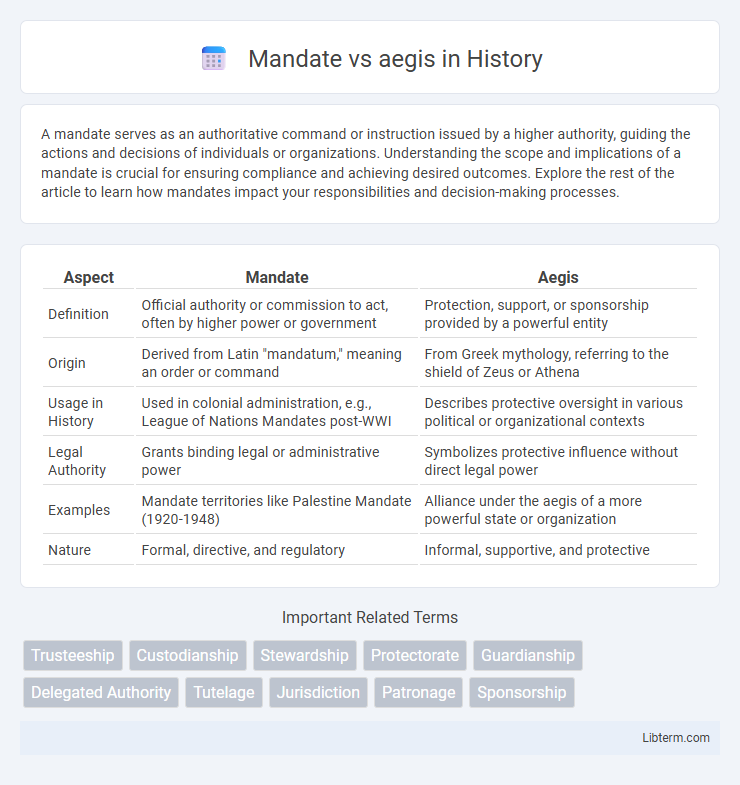A mandate serves as an authoritative command or instruction issued by a higher authority, guiding the actions and decisions of individuals or organizations. Understanding the scope and implications of a mandate is crucial for ensuring compliance and achieving desired outcomes. Explore the rest of the article to learn how mandates impact your responsibilities and decision-making processes.
Table of Comparison
| Aspect | Mandate | Aegis |
|---|---|---|
| Definition | Official authority or commission to act, often by higher power or government | Protection, support, or sponsorship provided by a powerful entity |
| Origin | Derived from Latin "mandatum," meaning an order or command | From Greek mythology, referring to the shield of Zeus or Athena |
| Usage in History | Used in colonial administration, e.g., League of Nations Mandates post-WWI | Describes protective oversight in various political or organizational contexts |
| Legal Authority | Grants binding legal or administrative power | Symbolizes protective influence without direct legal power |
| Examples | Mandate territories like Palestine Mandate (1920-1948) | Alliance under the aegis of a more powerful state or organization |
| Nature | Formal, directive, and regulatory | Informal, supportive, and protective |
Understanding the Concepts: Mandate vs Aegis
Mandate refers to the official authority or instruction granted to an individual or organization to carry out a specific task or function. Aegis denotes protection, support, or sponsorship provided by a person or institution, often implying a guardian role. Understanding the difference between mandate and aegis is crucial for clarifying responsibilities and the nature of authority versus protection in organizational or legal contexts.
Historical Background of Mandates and Aegis
Mandates originated from the League of Nations after World War I, designed to govern former territories of the Central Powers under international supervision, ensuring eventual self-governance or independence. The aegis concept historically refers to protection or patronage, often used in classical antiquity to denote the shield or breastplate associated with Zeus and Athena, symbolizing authoritative guardianship. Mandates represent formal political administration roles, while aegis implies symbolic or protective oversight without direct governance.
Key Differences Between Mandate and Aegis
Mandate refers to an authoritative command or instruction given by a higher authority, establishing the scope of responsibility or action. Aegis denotes protection, sponsorship, or support provided by an influential organization or authority, often implying a shield or defense. The key difference lies in mandate defining the duty or authorization to act, while aegis emphasizes guardianship or endorsement under which actions are carried out.
Legal Frameworks: Mandate vs Aegis
Mandate refers to the legal authorization granted by a higher authority, such as a government or international body, empowering an organization or individual to perform specific actions within defined parameters. Aegis denotes the protection, backing, or support provided under a legal framework, often ensuring legitimacy and enforcement of policies or operations. The distinction lies in mandate establishing the official authority to act, while aegis offers the legal shield or endorsement that secures and defends those actions.
Applications in International Relations
Mandate and aegis represent distinct frameworks within international relations, with mandates referring to legal obligations granted by entities like the League of Nations to administer territories, while aegis denotes protective authority or sponsorship often exercised by powerful states or international organizations. Mandates have been pivotal in post-colonial state formation and governance, exemplified by the League of Nations mandates in the Middle East. Aegis serves in contemporary diplomacy as a vehicle for coalition-building and peacekeeping, where states act under the aegis of the United Nations or regional bodies to enforce international law and maintain security.
Mandate and Aegis in Organizational Governance
Mandate in organizational governance refers to the authoritative directive or official instruction given to a governing body or individual to perform specific functions or make decisions within a defined scope. Aegis represents the protective oversight or support provided by an organization, ensuring compliance, accountability, and alignment with strategic goals. Understanding the distinction between mandate and aegis is crucial for clarifying roles, responsibilities, and the extent of authority in corporate governance frameworks.
Impact on Policy Implementation
Mandate provides explicit authority and clear directives that drive decisive policy implementation, ensuring accountability and measurable outcomes. Aegis offers protective oversight and support frameworks that facilitate smoother policy adoption by minimizing resistance and enhancing stakeholder cooperation. The interplay between mandate and aegis shapes the effectiveness and sustainability of policy execution across governmental and organizational contexts.
Advantages and Limitations of Mandate and Aegis
Mandate grants specific authority and clear legal responsibility, ensuring focused governance and accountability, but may limit flexibility and adaptability in dynamic situations. Aegis offers protective oversight and broader support without direct control, promoting collaboration and shared responsibility, yet it can result in ambiguous accountability and slower decision-making. Understanding these distinctions is crucial for optimizing organizational structures and operational effectiveness.
Case Studies: Mandate vs Aegis in Practice
Case studies comparing Mandate and Aegis reveal distinct approaches to project management and security enforcement in large-scale enterprises. Mandate emphasizes clear directive authority, ensuring compliance and streamlined decision-making, while Aegis focuses on protective measures and risk mitigation through layered defense strategies. Real-world applications demonstrate Mandate's efficiency in regulatory environments and Aegis's strength in safeguarding assets against cyber threats.
Choosing the Right Approach: Mandate or Aegis
Choosing between Mandate and Aegis depends on the organization's need for control versus protection. Mandate provides clear directives and authority to enforce rules, ideal for governance requiring strict compliance. Aegis emphasizes safeguarding and oversight, suitable for environments prioritizing risk management and security.
Mandate Infographic

 libterm.com
libterm.com